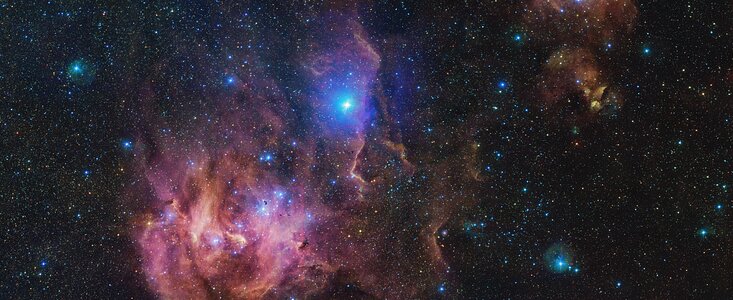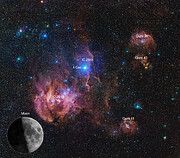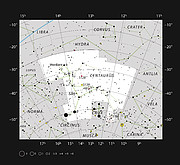Press Release
New 1.5-billion-pixel ESO image shows Running Chicken Nebula in unprecedented detail
21 December 2023
While many holiday traditions involve feasts of turkey, soba noodles, latkes or Pan de Pascua, this year, the European Southern Observatory (ESO) is bringing you a holiday chicken. The so-called Running Chicken Nebula, home to young stars in the making, is revealed in spectacular detail in this 1.5-billion-pixel image captured by the VLT Survey Telescope (VST), hosted at ESO’s Paranal site in Chile.
This vast stellar nursery is located in the constellation Centaurus (the Centaur), at about 6500 light-years from Earth. Young stars within this nebula emit intense radiation that makes the surrounding hydrogen gas glow in shades of pink.
The Running Chicken Nebula actually comprises several regions, all of which we can see in this vast image that spans an area in the sky of about 25 full Moons [1]. The brightest region within the nebula is called IC 2948, where some people see the chicken’s head and others its rear end. The wispy pastel contours are ethereal plumes of gas and dust. Towards the centre of the image, marked by the bright, vertical, almost pillar-like, structure, is IC 2944. The brightest twinkle in this particular region is Lambda Centauri, a star visible to the naked eye that is much closer to us than the nebula itself.
There are, however, many young stars within IC 2948 and IC 2944 themselves — and while they might be bright, they’re most certainly not merry. As they spit out vast amounts of radiation, they carve up their environment much like, well, a chicken. Some regions of the nebula, known as Bok globules, can withstand the fierce bombardment from the ultraviolet radiation pervading this region. If you zoom in to the image, you might see them: small, dark, and dense pockets of dust and gas dotted across the nebula.
Other regions pictured here include, to the upper right, Gum 39 and 40, and to the lower right, Gum 41. Aside from nebulae, there are countless orange, white and blue stars, like fireworks in the sky. Overall in this image, there are more wonders than can be described — zoom in and pan across, and you’ll have a feast for the eyes.
This image is a large mosaic comprising hundreds of separate frames carefully stitched together. The individual images were taken through filters that let through light of different colours, which were then combined into the final result presented here. The observations were conducted with the wide-field camera OmegaCAM on the VST, a telescope owned by the National Institute for Astrophysics in Italy (INAF) and hosted by ESO at its Paranal site in Chile’s Atacama Desert that is ideally suited for mapping the southern sky in visible light. The data that went into making this mosaic were taken as part of the VST Photometric Hα Survey of the Southern Galactic Plane and Bulge (VPHAS+), a project aimed at better understanding the life cycle of stars.
Notes
[1] This image, edge to edge, is 270 light-years wide. It would take an average chicken almost 21 billion years to run across it. That’s much longer than our Universe has been around for.
More information
The European Southern Observatory (ESO) enables scientists worldwide to discover the secrets of the Universe for the benefit of all. We design, build and operate world-class observatories on the ground — which astronomers use to tackle exciting questions and spread the fascination of astronomy — and promote international collaboration for astronomy. Established as an intergovernmental organisation in 1962, today ESO is supported by 16 Member States (Austria, Belgium, Czechia, Denmark, France, Finland, Germany, Ireland, Italy, the Netherlands, Poland, Portugal, Spain, Sweden, Switzerland and the United Kingdom), along with the host state of Chile and with Australia as a Strategic Partner. ESO’s headquarters and its visitor centre and planetarium, the ESO Supernova, are located close to Munich in Germany, while the Chilean Atacama Desert, a marvellous place with unique conditions to observe the sky, hosts our telescopes. ESO operates three observing sites: La Silla, Paranal and Chajnantor. At Paranal, ESO operates the Very Large Telescope and its Very Large Telescope Interferometer, as well as survey telescopes such as VISTA. Also at Paranal ESO will host and operate the Cherenkov Telescope Array South, the world’s largest and most sensitive gamma-ray observatory. Together with international partners, ESO operates ALMA on Chajnantor, a facility that observes the skies in the millimetre and submillimetre range. At Cerro Armazones, near Paranal, we are building “the world’s biggest eye on the sky” — ESO’s Extremely Large Telescope. From our offices in Santiago, Chile we support our operations in the country and engage with Chilean partners and society.
Links
- Photos of the survey telescopes at Paranal, including VST
- For journalists: subscribe to receive our releases under embargo in your language
- For scientists: got a story? Pitch your research
Contacts
Juan Carlos Muñoz Mateos
ESO Media Officer
Garching bei München, Germany
Tel: +49 89 3200 6176
Email: jmunoz@eso.org
Bárbara Ferreira
ESO Media Manager
Garching bei München, Germany
Tel: +49 89 3200 6670
Cell: +49 151 241 664 00
Email: press@eso.org
About the Release
| Release No.: | eso2320 |
| Name: | IC 2944, Running Chicken Nebula |
| Type: | Milky Way : Nebula : Type : Star Formation Milky Way : Nebula : Appearance : Emission : H II Region |
| Facility: | VLT Survey Telescope |
| Instruments: | OmegaCAM |
Our use of Cookies
We use cookies that are essential for accessing our websites and using our services. We also use cookies to analyse, measure and improve our websites’ performance, to enable content sharing via social media and to display media content hosted on third-party platforms.
ESO Cookies Policy
The European Organisation for Astronomical Research in the Southern Hemisphere (ESO) is the pre-eminent intergovernmental science and technology organisation in astronomy. It carries out an ambitious programme focused on the design, construction and operation of powerful ground-based observing facilities for astronomy.
This Cookies Policy is intended to provide clarity by outlining the cookies used on the ESO public websites, their functions, the options you have for controlling them, and the ways you can contact us for additional details.
What are cookies?
Cookies are small pieces of data stored on your device by websites you visit. They serve various purposes, such as remembering login credentials and preferences and enhance your browsing experience.
Categories of cookies we use
Essential cookies (always active): These cookies are strictly necessary for the proper functioning of our website. Without these cookies, the website cannot operate correctly, and certain services, such as logging in or accessing secure areas, may not be available; because they are essential for the website’s operation, they cannot be disabled.
Functional Cookies: These cookies enhance your browsing experience by enabling additional features and personalization, such as remembering your preferences and settings. While not strictly necessary for the website to function, they improve usability and convenience; these cookies are only placed if you provide your consent.
Analytics cookies: These cookies collect information about how visitors interact with our website, such as which pages are visited most often and how users navigate the site. This data helps us improve website performance, optimize content, and enhance the user experience; these cookies are only placed if you provide your consent. We use the following analytics cookies.
Matomo Cookies:
This website uses Matomo (formerly Piwik), an open source software which enables the statistical analysis of website visits. Matomo uses cookies (text files) which are saved on your computer and which allow us to analyze how you use our website. The website user information generated by the cookies will only be saved on the servers of our IT Department. We use this information to analyze www.eso.org visits and to prepare reports on website activities. These data will not be disclosed to third parties.
On behalf of ESO, Matomo will use this information for the purpose of evaluating your use of the website, compiling reports on website activity and providing other services relating to website activity and internet usage.
Matomo cookies settings:
Additional Third-party cookies on ESO websites: some of our pages display content from external providers, e.g. YouTube.
Such third-party services are outside of ESO control and may, at any time, change their terms of service, use of cookies, etc.
YouTube: Some videos on the ESO website are embedded from ESO’s official YouTube channel. We have enabled YouTube’s privacy-enhanced mode, meaning that no cookies are set unless the user actively clicks on the video to play it. Additionally, in this mode, YouTube does not store any personally identifiable cookie data for embedded video playbacks. For more details, please refer to YouTube’s embedding videos information page.
Cookies can also be classified based on the following elements.
Regarding the domain, there are:
- First-party cookies, set by the website you are currently visiting. They are stored by the same domain that you are browsing and are used to enhance your experience on that site;
- Third-party cookies, set by a domain other than the one you are currently visiting.
As for their duration, cookies can be:
- Browser-session cookies, which are deleted when the user closes the browser;
- Stored cookies, which stay on the user's device for a predetermined period of time.
How to manage cookies
Cookie settings: You can modify your cookie choices for the ESO webpages at any time by clicking on the link Cookie settings at the bottom of any page.
In your browser: If you wish to delete cookies or instruct your browser to delete or block cookies by default, please visit the help pages of your browser:
Please be aware that if you delete or decline cookies, certain functionalities of our website may be not be available and your browsing experience may be affected.
You can set most browsers to prevent any cookies being placed on your device, but you may then have to manually adjust some preferences every time you visit a site/page. And some services and functionalities may not work properly at all (e.g. profile logging-in, shop check out).
Updates to the ESO Cookies Policy
The ESO Cookies Policy may be subject to future updates, which will be made available on this page.
Additional information
For any queries related to cookies, please contact: pdprATesoDOTorg.
As ESO public webpages are managed by our Department of Communication, your questions will be dealt with the support of the said Department.





